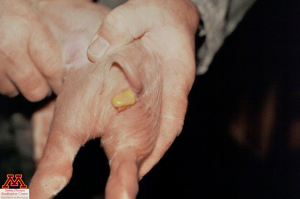Enteric System: Pre-Weaning Pigs
Colibacillosis
Clinical importance
Escherichia coli can have many clinical presentations in pigs of various age groups: diarrhea in suckling piglets, neurological signs in nursery pigs or urinary tract infections in sows. This chapter will focus on neonatal diarrhea caused Enterotoxigenic Escherichia coli (ETEC). Colibacillosis can affect pigs of all age but the consequences are more severe in baby piglets. Indeed, neonatal colibacillosis is an old and ubiquitous disease, present in every country raising pigs. It has a high morbidity and a variable mortality (up to 70%) mainly dependent upon the rapidity of the intervention. Economic losses can therefore be important.
E. coli can infect humans but the risk of zoonosis is almost nonexistent since the strains affecting swine are of low virulence in humans.
Etiology and Transmission
There are many different strains of E. Coli than can be differentiated by their type of antigen, including Somatic (O), capsular (K), flagellar (H), and fimbrial (F). The most common pathogenic strains in neonatal swine are K88, K99, and 987P. E.coli are a normal part of the intestinal flora of pigs. Therefore, piglets get contaminated at farrowing. If cleaning and disinfection procedures are inadequate, the bacterial load in the environment increases and the piglets ingests a high number of bacteria from the intestinal flora of the sow while exploring and suckling. The bacteria then make their way to the jejunum and ileum, where they attach to the enterocytes and liberate their toxins, causing diarrhea. They are then shed in the piglets’ fecal matter. The main route of transmission is feco-oral but a aerosols as well as contaminated environments can also infect a new litter.
Associated symptoms

The most common symptom in neonatal pigs is diarrhea. Its appearance can vary a lot: mild to profuse, watery, whitish to light brown. to Often observed within hours of birth, mostly between 0 and 4 days of age. Piglets with low levels of maternal antibodies such as piglets that did not receive enough colostrum and litters issued from gilts are especially at risk. Piglets become dehydrated, and the more severe the diarrhea, the more severe the dehydration and the risk of mortality. Another very common time for pigs to develop colibacillosis is just after weaning, due to the transition from liquid to solid feed and the stress of the separation from the sow. In this case, mortality is rare and clinical signs are limited to a mild to moderate diarrhea. Pigs of all ages can be affected but the older animal only present mild signs.
Associated lesions
Macroscopic lesions
The most common lesions seen are those associated with dehydration. The intestine and stomach may be inflamed or filled with fluid or gas.
Microscopic lesions
Under the microscope, high amounts of bacteria are found attached to the epithelium of the villi or less commonly around the crypts in the jejunum or ileum of the pigs.
Diagnosis
Best samples to take when looking to establish a colibacillosis diagnosis are fecal samples, rectal swabs, or intestinal tissue. A variety of tests can be run but culture and isolation is the most frequent. There is also a preliminary test that can be run on stool sample of still living pigs to differentiate between E. coli and viral infections. Put litmus paper into the sample and if the paper turns red (acidic) it is most likely a viral infection. If the paper turns blue (alkaline) the diarrhea is most likely caused by E. coli.
Differential diagnosis
A differential diagnosis for young piglets with diarrhea must also include Clostridium infections, rotaviruses, and coronaviruses. In older pigs, PED, salmonellosis, ileitis and colitis due to Brachyspira pilosicoli need to be considered.
Treatment, Prevention and Control
Treatments are available for an E. coli infection, the most commonly used of which are antibiotics to kill the bacteria and fluids to prevent dehydration. A good option are antibiotics in the family of aminoglycosides which are given orally and are poorly absorbed through the intestine. Therefore, their concentration in the lumen stays stable and eliminates the pathogen. Antibiotics should be used on a case by case basis and should not be a long-term solution. The best way to prevent against infection is by providing a clean and dry environment for the piglets. The farrowing area should be kept at a comfortably warm temperature (70 degrees), and any area with exclusively small piglets should be kept even warmer to prevent chilling. Farrowing rooms should also be cleaned and disinfected regularly and should be set up in such a way that the sow’s fecal matter is kept away from the piglets. E. coli also grows better in moist environments, so drier environments are safer for young pigs. Biosecurity measures should be in place to prevent any outside sources of E. coli from entering the farrowing area.
Lastly, vaccinating the sows 2 to 3 weeks before farrowing is a good way to increase their antibodies’ production and to give the piglets a protective passive immunity through the colostrum. Numerous commercial vaccines are available, often combining E.coli and several species of Clostridia.
In cases of post-weaning diarrhea, the transition between the farrowing room and the nursery should be made as easy as possible on the pig. A warm environment and providing piglets with solid feed before they are weaned can be helpful in preventing clinical signs. Prevention is also done can adding antimicrobials such as carbadox or minerals such as zinc in the first nursery diet.
Published on: July 30, 2018

